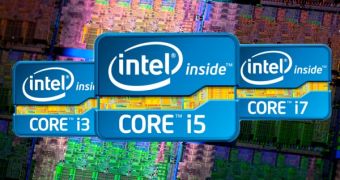UPDATE: Our review of the Sandy Bridge CPUs is up, and we invite you to take a look and see for yourselves what Intel's latest CPUs are really capable of. After teasing its Sandy Bridge platform for more than a half a year now, with countless leaks occurring over the past couple of months, Intel has decided to go a bit ahead of schedule and officially unveiled its “2nd Generation Intel Core processor family” before the official start of CES 2011, in all its full glory.
Of course, the official announcements comes to confirm many of the rumors we've talked about over time, but also adds some interesting new details, related especially to the new technologies and features embedded in the 2011 Core family.
So, first and foremost, we'll have to point out that, as Engadget reports, the new CPU series includes no less that 29 models, both desktop and mobile versions, divided as follows: four Core i3 CPUs (one mobile, three desktop), twelve Core i5 CPUs (four mobile, eight desktop), twelve core i7 CPUs (nine mobile, three desktop) and a flagship mobile Core i7 CPU, the i7-2920XM.
It's actually quite interesting to see that, as far as the more powerful processors in the Sandy Bridge lineup are concerned, Intel's decided to go mostly mobile, practically acknowledging the decreasing popularity of desktop systems at the hand of powerful laptops/notebooks.
Now, moving back to what the 2nd Generation Intel Core processor family brings new to the picture, we'll obviously have to start with the newly architected Intel HD Graphics on each 32nm die, that enables significant graphics performance improvements over previous generation graphics, for both HD media processing and mainstream gaming.
It's also important to mention that the chips are made on Intel's 32 nanometer manufacturing process on the company's second-generation high-k metal gate transistors, these unique advantages further boosting performance, reducing power consumption for better battery life and smaller designs, and lowering the overall manufacturing costs.
Another interesting new features are Intel Insider, Intel Quick Sync Video, and a new version of the company's award-winning Intel Wireless Display (WiDi), which now adds 1080p HD and content protection for those wishing to beam premium HD content from their laptop screen to their TV.
The Core i3, i5 and i7 processors also include the enhanced Intel Turbo Boost Technology 2.0, a feature that automatically reallocates processor core and processor graphics resources to accelerate performance, giving users an immediate performance boost when and where it's needed.
Other new chip features include Intel Advanced Vector Extensions (AVX), Intel InTru 3-D, and Intel Clear Video Technology HD.
Intel InTru 3-D enables immersive stereoscopic 3D to 3D-capable HDTVs or monitors via HDMI 1.4, making movie excitement almost come out of the screen, while Intel AVX increases performance for demanding visual applications like audio processing and professional video image editing like stitching together multiple photographs.
Finally, Intel Clear Video improves the visual quality and color fidelity during video playback for a spectacular screen experience.
That's just about it, for the time being, but we promise to come back with more info on the new Core family today, detailing some of the features the Sandy Bridge platform provides.

 14 DAY TRIAL //
14 DAY TRIAL //